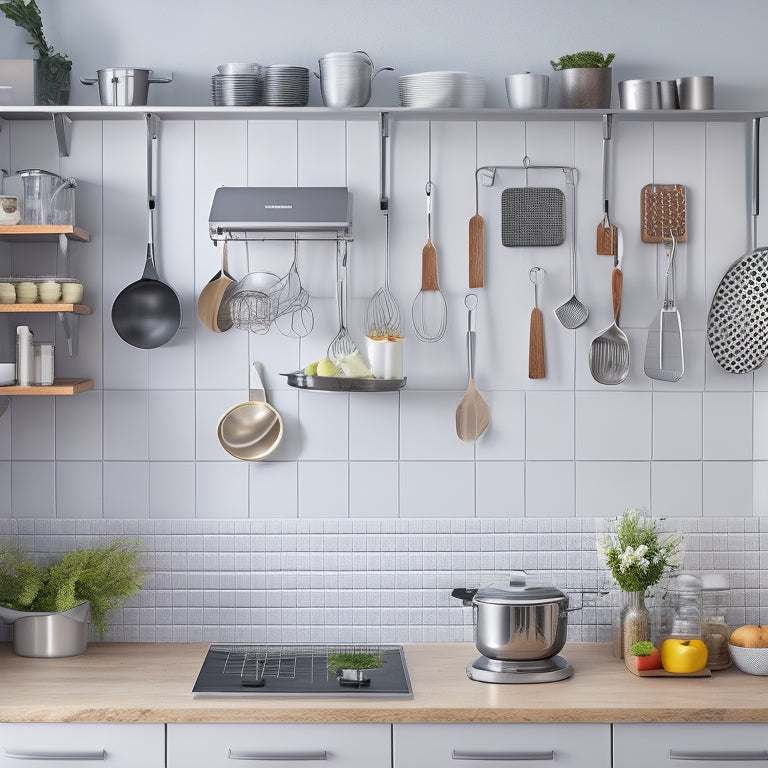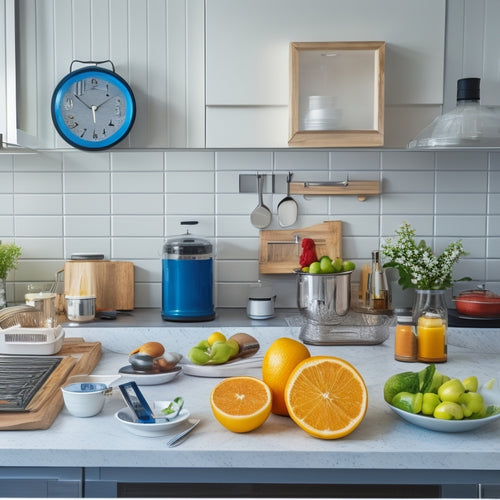
7 Essential Tools for Apartment Kitchen Efficiency
Share
You're just a few strategic tools away from transforming your apartment kitchen into a haven of efficiency, where every minute counts and every inch is maximized. Start by using a kitchen design and layout planner to optimize your space. Next, implement meal planning and grocery lists to streamline your workflow. Don't forget to organize your pantry inventory, and master recipe management and scaling. Stay on top of tasks and deadlines with reminders, and optimize your storage and shelving. Finally, schedule regular cleaning and maintenance to keep your kitchen in top shape. Take the next step to reveal a more efficient you.
Key Takeaways
• A well-planned kitchen design and layout can maximize efficiency and identify areas for space-saving solutions in an apartment kitchen.
• Meal planning and grocery lists can simplify kitchen workflow, establish a routine, and create a budget-friendly menu for apartment dwellers.
• Organizing pantry inventory with a labeling system and tracking expiration dates can reduce food waste and save time in a small kitchen.
• Effective kitchen task and deadline reminders can help prioritize tasks, set notifications, and utilize digital tools for task management in a compact space.
• A storage and shelving optimizer can assign designated spots for items, utilize space-saving solutions, and install adjustable shelves to maximize storage potential.
Kitchen Design and Layout Planner
Planning your kitchen design and layout is essential to maximizing efficiency, and a kitchen design and layout planner helps you visualize and optimize your space. By using this tool, you'll be able to identify areas where you can implement space-saving solutions, creating a functional layout that streamlines your workflow.
You'll be able to assess your kitchen's dimensions, door and window placement, and electrical outlet locations to create a tailored design that meets your needs. With a kitchen design and layout planner, you'll also be able to balance design aesthetics with ergonomic workflow, ensuring that your kitchen is both visually appealing and highly functional.
Meal Planning and Grocery Lists
You'll simplify your kitchen workflow by establishing a routine that starts with meal planning and grocery lists, allowing you to strategically prepare and shop for ingredients. This essential step helps you create a budget-friendly menu, making sure you're cooking up delicious meals without breaking the bank.
Look for recipes that utilize affordable protein sources, like beans or eggs, and incorporate seasonal produce to reduce costs. When planning your meals, consider cooking in bulk and repurposing leftovers to minimize food waste and save time.
As you create your grocery list, implement shopping tips like buying in bulk, using cashback apps, and shopping during sales. This will help you stay within your budget and maximize your savings.
To further optimize your kitchen workflow, implement meal prep strategies like cooking entire meals on the weekend or prep-cooking individual ingredients. This will save you time during the week and make sure you're cooking healthy, home-cooked meals even on the busiest of days.
Pantry Organization and Inventory
Organizing your pantry inventory is a crucial step in maintaining kitchen efficiency, as it allows you to quickly identify what ingredients you have on hand and what you need to restock. To accomplish this, implement a labeling system that categorizes items by type, such as baking supplies, spices, and snacks. This will enable you to locate items swiftly and prevent clutter from accumulating.
Additionally, consider inventory tracking to monitor expiration dates and usage rates. This will help you avoid expired or spoiled food and optimize your grocery lists.
To maximize your pantry's storage capacity, incorporate space-saving solutions like adjustable shelves, baskets, and containers. These organization hacks will keep your pantry tidy and guarantee that every item has a designated home. By doing so, you'll reduce food waste, save time, and make meal planning a breeze.
With a well-organized pantry, you'll be able to focus on cooking up a storm, rather than wasting time searching for ingredients or dealing with clutter.
Recipe Management and Scaling
Efficient recipe management and scaling are essential skills to master, as they enable you to effortlessly double or halve ingredients, convert between measurement units, and make substitutions on the fly. With these skills, you'll be able to adapt recipes to your dietary needs and preferences, ensuring you cook with confidence and precision.
To take your recipe management to the next level, consider the following strategies:
-
Master ingredient substitution: Learn to swap out ingredients with similar alternatives, ensuring you can still achieve the desired flavor and texture.
-
Optimize portion control: Scale recipes up or down to suit your needs, whether you're cooking for one or a crowd.
-
Customize recipes for nutritional analysis: Use online tools or apps to analyze the nutritional content of your recipes, making it easy to make healthy adjustments.
Kitchen Task and Deadline Reminders
With your recipes optimized and scaled to perfection, it's time to turn your attention to staying on top of kitchen tasks and deadlines to make sure seamless meal prep and cooking.
Effective time management and task prioritization are vital to achieving this goal. You need a system that helps you keep track of tasks, such as meal planning, grocery shopping, and food prep, and reminds you of upcoming deadlines. This is where reminder notifications and deadline tracking come in.
You can use a digital tool, like a kitchen app or a task management platform, to set reminders and track deadlines. These tools allow you to categorize tasks, set priorities, and allocate time for each task. You can also set recurring reminders for regular tasks, like weekly meal planning or monthly pantry organization.
Storage and Shelving Optimizer
You'll optimize your kitchen's storage potential by implementing a shelving system that assigns a designated spot for every item, making it easy to find what you need when you need it. This is especially vital in small apartment kitchens where space is limited.
By utilizing space saving solutions and organization techniques, you'll be able to fit more items in a smaller area, keeping your kitchen clutter-free and efficient.
Here are some efficiency hacks to help you enhance your storage and shelving:
-
Install adjustable shelves: These allow you to customize the height and layout of your shelves to fit different sized items, making the most of your vertical space.
-
Use stackable containers: Label and store items like spices, oils, and snacks in stackable containers to keep them organized and out of the way.
-
Designate a 'junk drawer': Assign a single drawer or shelf for miscellaneous items like takeout menus, coupons, and appliance manuals, keeping them from cluttering your countertops.
Kitchen Cleaning and Maintenance Scheduler
Every week, allocate 30 minutes to uphold your kitchen's cleanliness and organization by scheduling tasks like wiping down countertops, cleaning the stove, and tidying up cluttered areas. This habit will keep your kitchen running smoothly and prevent messy buildups.
To make the most of your cleaning session, create a rotation schedule for your cleaning supplies to make sure you're using the right products for each task. For example, assign a specific cleaner for the countertops and another for the stove.
In addition to cleaning, prioritize appliance maintenance to prevent breakdowns and extend their lifespan. Develop a checklist tracker to monitor your progress and stay on top of tasks like cleaning the oven, replacing water filters, and checking expiration dates of perishable items.
Frequently Asked Questions
How Do I Prevent Kitchen Utensils From Cluttering My Countertops?
"You've got a million utensils competing for countertop real estate, but don't let them win! Invest in clever organizing solutions and utensil storage to achieve a minimalist kitchen design, where clutter-free counters are the ultimate prize."
Can I Use a Kitchen Cart as Additional Counter Space?
You can utilize a kitchen cart as additional counter space, leveraging its versatility to optimize your small kitchen. By incorporating smart organization tips, you'll maximize counter space, creating a seamless workflow that boosts your culinary productivity.
Are There Any Eco-Friendly Kitchen Cleaning Products Available?
You're on a mission to greenify your cleaning routine! Look for eco-friendly kitchen cleaning products with natural ingredients, biodegradable options, and homemade solutions. Sustainable alternatives like baking soda and vinegar can replace harsh chemicals, giving you a sparkling clean kitchen with a clear conscience.
How Often Should I Replace My Kitchen Sponge?
"Imagine germ-infested sponges breeding bacteria like a petri dish! You should replace yours every 1-3 months or sooner if it smells, falls apart, or shows signs of mold. Opt for sponge alternatives like silicone scrubbers for better sanitation and durability."
What Are Some Space-Saving Ideas for a Small Kitchen Island?
When choosing a small kitchen island, you'll want to prioritize hidden storage and portable functionality. Opt for a cart with built-in shelves, drawers, or a butcher-block top that can be easily moved around your space.
Related Posts
-
Versatile Stainless Steel Alligator Chip Bag Clip For Fresh Food Storage
In a world filled with technological advancements and complex gadgets, it is refreshing to find simplicity in everyda...
-

5 Best Ways to Boost Kitchen Productivity Online
You can significantly enhance your kitchen productivity by leveraging online resources and tools, freeing up time and...
